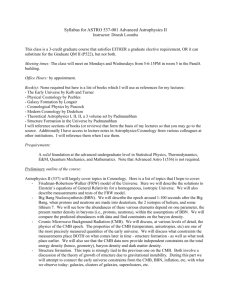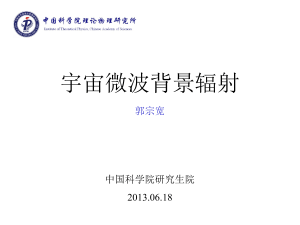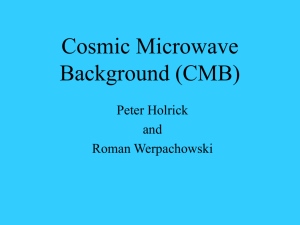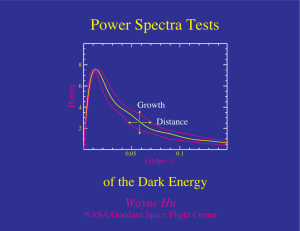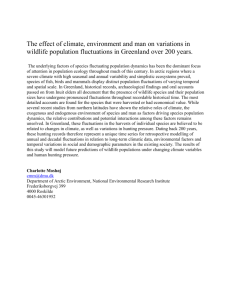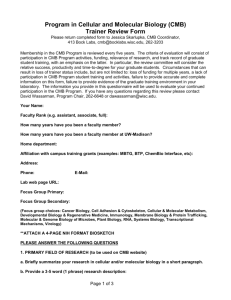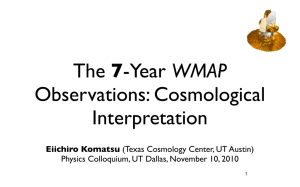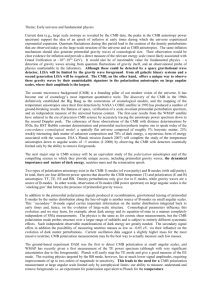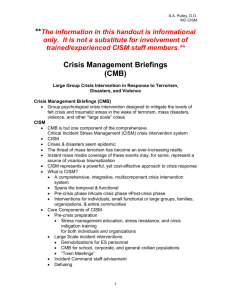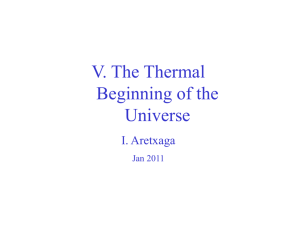The Cosmic Microwave Background
advertisement
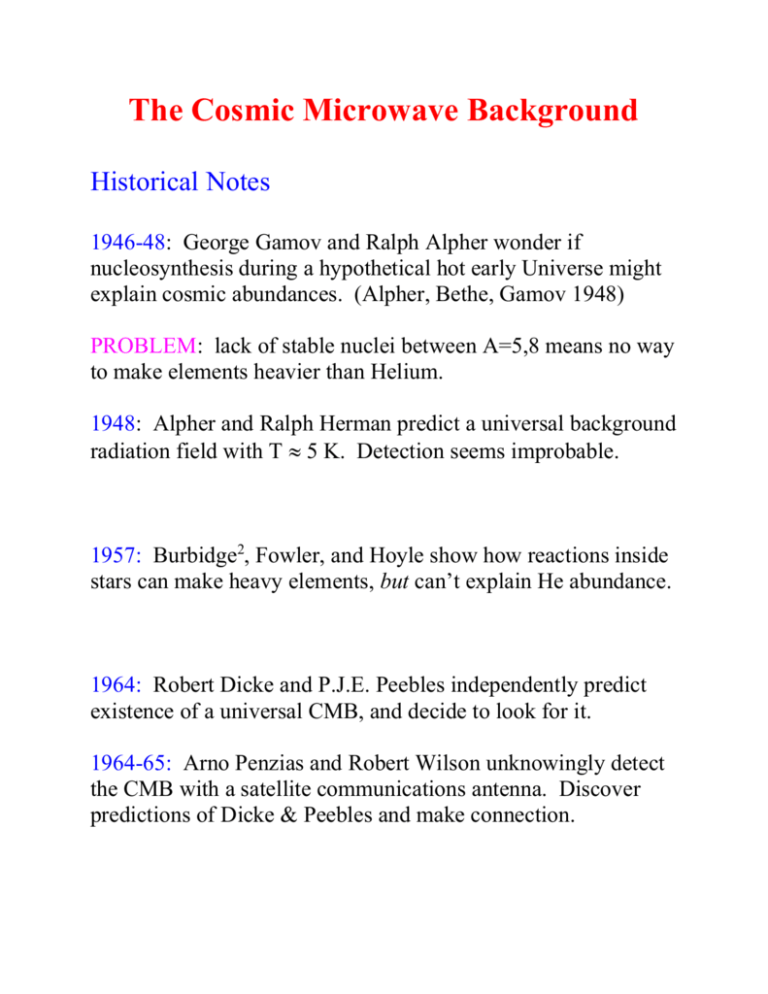
The Cosmic Microwave Background Historical Notes 1946-48: George Gamov and Ralph Alpher wonder if nucleosynthesis during a hypothetical hot early Universe might explain cosmic abundances. (Alpher, Bethe, Gamov 1948) PROBLEM: lack of stable nuclei between A=5,8 means no way to make elements heavier than Helium. 1948: Alpher and Ralph Herman predict a universal background radiation field with T 5 K. Detection seems improbable. 1957: Burbidge2, Fowler, and Hoyle show how reactions inside stars can make heavy elements, but can’t explain He abundance. 1964: Robert Dicke and P.J.E. Peebles independently predict existence of a universal CMB, and decide to look for it. 1964-65: Arno Penzias and Robert Wilson unknowingly detect the CMB with a satellite communications antenna. Discover predictions of Dicke & Peebles and make connection. Investigating the CMB How rapidly does the Universe cool? Consider black body radiation of energy density u. Two effects reduce u as the Universe expands: 1. All volumes become larger (remember that r(t) = R(t)r0). 2. Cosmological redshift: Time intervals measured by photon frequencies become larger as the Universe expands. Photon wavelengths therefore become larger. Combine these effects to see how the energy density of photons in a small wavelength interval evolves: u0 d0 R 3 R u(t )d (t ) Assume that, like photon wavelengths, the temperature depends on time. At time t the energy density is 8hc (t ) 5 u (t ) exp hc / (t )kT (t ) 1 . Since the cosmological redshift means that (t ) 0 R , the energy density becomes 8hcR0 u (t ) exp hc / R0 kT (t ) 1 . 5 Therefore, the present energy density in interval d0 is given by 8hcR0 u0 d0 R Rd 0 . exp hc / 0 k RT (t ) 1 5 4 Clearly, however, the present energy density must be given by 8hc05 u0 exp hc / 0 kT0 1 , so evidently we must conclude that T0 R T (t ) , or, in other words, that RT(t) = constant. Estimating the Present Temperature Use likely values for conditions during the synthesis of He: T 109 K, and 10-5 gram cm-3. These values are chosen because: Nucleosynthesis can’t proceed at much lower temperature. Deuterium, the fuel for Helium production, is photodissociated at much higher temperature. Present isotopic abundance ratios of He and H can’t be produced at much different densities. Recall that equation 8) states that 0 R 3 , and the present baryon density is believed to be B,0 0.6 1030 grams cm-3. So the value of R during Helium production was about R 0 1/ 3 0.6 10 30 5 10 1/ 3 0.6 10 25 1/ 3 3.9 10 9 Therefore, since we’ve just found that T0 R T (t ) , we predict that T0 3.9 10 9 10 9 3.9 K. When expressed in terms of intensity per unit wavelength, B, black body radiation of this temperature peaks at MAX 2.9 0.7 mm. T0 The Cosmic Background Explorer Nov 1989 launch COBE nails the temperature of the CMB The CMB (top) and the Dipole Anisotropy Interpreting the Dipole Anisotropy of the CMB Suppose that the Sun is moving with peculiar velocity v with respect to the Hubble flow. CMB radiation received on earth from direction with respect to the vector v will be Doppler shifted, and the spectrum of light from this direction will be that of a black body of temperature v2 1 2 c T ( ) TREST v 1 cos . c Assuming that v << c, we can represent the numerator and denominator on the RHS by binomial series, retaining lowest order terms in v/c. Thus v2 1 2 2 v 1 v v c 1 1 cos 1 cos 2 v c 1 cos 2 c c , c so that v T ( ) TREST 1 cos . c The amplitude of the observed anisotropy is about 1 part in 500, i.e. T (0 deg .) TMAX 1 1 T (180 deg .) TMIN 500 . Evaluate T() at its maximum and minimum directions: TMAX TCMB 1 v v T T 1 . MIN CMB c , and c Form the ratio TMAX / TMIN and solve for the ratio v / c. The result is TMAX 1 1 v TMIN 500 0.001 c TMAX 1 2 . TMIN Therefore, the Sun’s peculiar speed must be roughly v = 0.001c = 300 km s-1. After correcting for the (not well known) velocity of the Sun in the Local Group rest frame, one finds the peculiar velocity of the Local Group to be vLG 600 km s-1 towards (RA 10.5h , DEC -26). This represents the motion of the Local Group with respect to a reference frame at rest in the Hubble flow. The Radiation and Matter Eras We have found that the radiation density decreases according to u (t ) R 4 , while we already knew that the density of ordinary matter must decrease as R 3 . At very early times (i.e. small R), therefore, it seems that radiation might have accounted for most of the total massenergy density of the Universe. We want to find out when the two densities were equal and what conditions were like at that time. The total energy density of black body radiation at temperature T is u 4 4 T , c where is the Stefan-Boltzmann constant. The equivalent mass density can be obtained using Einstein’s famous relation E=mc2. Thus RAD u 4 4 2 3 T . c c Combining the above with the known dependence of radiation density on R shows that RAD (t ) RAD,0 R4 4 4 T 4 3 0 , Rc while for ordinary matter (t ) 0 R3 . When were the two densities equal? RAD (t ) (t ) 4 4 0 T 3 4 3 0 R c R So the two densities equal when 4T04 R 0c3 . But R = (1+ z)-1, so the this was the time when 0c3 1 z 4T04 . Replace 0 with more convenient quantities by noting that 0 0 C ,0 3H 02 0 8G , so that 3c 3 2.231 106 2 2 1 z H h 0 0 0 4 4 . 32 G T T 0 0 Stick in T0 =2.726 K, h = 0.71, and 0 = 1 to find that z 20,000 . The temperature at this time was T0 T0 1 z 2.726 2 10 4 5.5 10 4 K, R(t ) and the age of the Universe, for h = 0.71, was T (t ) t 3 / 2 2 2 3 / 2 t H 1 z 9.78 10 9 h 1 2 10 4 3200 yr. 3 3 The Recombination Epoch Because of photon scattering by free electrons, a brilliant plasma “fog” filled the early Universe. As the temperature declined, however, the fog eventually cleared. Clearing happened when free electrons could recombine with protons without immediately being re-ionized. Let’s assume this happened when half the Hydrogen was neutral. When did this happen, and what was the Universe like then? Estimate the value of R as follows: Assume that Hydrogen ionization could be approximately described by the Saha Equation: N II 2Z II 2me kT (t ) NI ne ( t ) Z I h2 3/ 2 exp I kT (t ) . where I is the ionization energy of state I (neutral Hydrogen), ZI, ZII are the partition functions for states I and II, respectively (number of different electron configurations having the same energy), ne, me are the number density of electrons and their mass. NOTE: assume that both ne and T were changing with time. Recall that T (t ) T0 R(t ) . Also, for a pure, half-ionized Hydrogen gas (neglecting other elements) the electron number density and total density are related through 2 ne m H . and the total density declines with R as 0 R 3 . Substitute into the Saha equation to express ne and T in terms of R, assuming that ZI and ZII are 2 and 1, respectively, and find N II 2mH R 3 2me kT0 2 NI B ,0 h R 3/ 2 exp I R kT0 . If there are equal numbers of neutrals and ions, then NII/NI = 1. As a function of R the Saha equation now has the form R 3 / 2 M exp NR , where M and N are positive constants. The book claims that the solution is RR 7.2 10 4 , but C&O appear to neglect the factor of 2 relating ne and . We’ll go with their result anyway. This scale factor corresponded with a redshift of 1 zR 1 1400 , RR and the temperature and age of the Universe were, respectively TR tR T0 RR 2.726 3800 K, and 7.2 10 4 2 3 / 2 9.78 10 9 h 1 1 1400 180,000 years, 3 for h = 0.71 and k = 0. FOOTNOTE: With Recombination, the Universe entered the so-called “Dark Ages”, which lasted until the first generations of stars reionized intergalactic space. Higher-order Fluctuations in the CMB After subtracting the Dipole fluctuation, COBE maps of the CMB show fainter ripples having angular size 10 (= COBE resolution), and T/T a few 10-5. A 10 feature seen at z 1000 has linear size 1000/(0h) Mpc, so these fluctuations are much larger than galaxies or galaxy clusters. Structure in the COBE map Mean-subtracted and Zodiacal light removed Dipole-subtracted Milky Way-subtracted Describing the Fluctuations Use spherical harmonics (orthogonal functions on a spherical surface): l T , T0 T , almYlm , . T T0 l 0 m l The Ylm are functions of Sin, Cos and exp(im), and the alm specify the amplitudes of the various terms. Think of Ylm as dividing the sphere into cells of dimension /l radians. The index l is called the multipole. COBE resolution: 10 l 20. Smaller angular features (larger l) can’t be resolved by COBE. The Power Spectrum Cl 1 2 Cl a a a lm lm lm , 2l 1 m which means that Cl measures the significance of fluctuations with angular sizes of /l radians. Synthetic “CMB Fluctuations” for Multipoles 2 and 16 Interpreting the Fluctuations – the Sachs-Wolf Effect In 1967, only 2 years after the discovery of the CMB, Sachs and Wolf predict that it should contain large-scale fluctuations. Photons become slightly redshifted while climbing out of the large but shallow potential wells of random density fluctuations. Let k fluctuation wavenumber = 1/(size of fluctuation), and assume that the spectral power P has the form P( k ) k n . Larger P indicates more numerous fluctuations. The angular size of the redshift-induced temperature fluctuations can be shown to look like 1 n T 2 , T and since there are reasonable grounds for expecting n 1, one anticipates that Cl const . until fluctuations begin to wash out at angular scales of 0.2 deg . , that is, for l 1000. Smaller fluctuations smear out over the time needed for recombination to occur. CONCLUSION: The Sachs-Wolf effect provides information about the power spectrum of initial fluctuations on large scales – the origin of the filamentary network recorded by large scale surveys (e.g. SDSS, 2MASS) All by itself, then, the signature of LSS should be a nearly constant value of Cl for l < 1000, which should rapidly decline for larger multipoles. The Acoustic Peaks Fluctuations with angular scales of 0.2 – 4 degrees (900 l 50) are measured by the recent Boomerang and MAXIMA balloon experiments, by the DASI radiometer at the South Pole, and most recently by WMAP. Important fact: Before recombination, the Jeans length was so large that perturbations of any size were stable. Rather than collapsing, all perturbations would propagate as sound waves. Maximum wavelength of sound waves in a universe of age t is S sound _ speed t c t, 3 and such waves should have angular sizes of S 0.310/ 2 degrees. d For 0 = 1, those waves should produce a peak in the angular power spectrum near multipole l 0.3 57.3 600 . More careful calculations predict a peak near l = 200 (0 = 1), or 430 (0 = 0.2). Higher multipole peaks and valleys occur on scales corresponding to max or min “sound” amplitudes at the time of recombination. Spacings and amplitudes of peaks depend on various combinations of H0, 0, and . BOTTOM LINE: The power spectrum of CMB fluctuations contains powerful constraints on possible world models. Four Recent Measurements of the CMB Angular Power Spectrum Boomerang MAXIMA at Palestine, Texas DASI looks up from the South Pole Measuring the Power Spectrum of the CMB The Wilkinson Microwave Anisotropy Probe (WMAP) Launch 2001 to the L2 point. 13’ resolution 3.2 – 13 mm wavelength coverage Intensity and polarization mapping Comparing dipole-subtracted maps of the CMB WMAP nails the power spectrum to l ~ 1000 Polarization data for l < 10 demands an epoch of reionization, and implies an electron scattering optical depth of τ = 0.17 ± 0.04 Cosmological constraints from CMB fluctuations Total density parameter Other density: the “Cosmological Constant” Electron scattering optical depth Fluctuation power spectrum Curves refer to different “priors” – Baryonic and cold dark matter densities Sievers et al. 2003 ApJ, 591, 599
